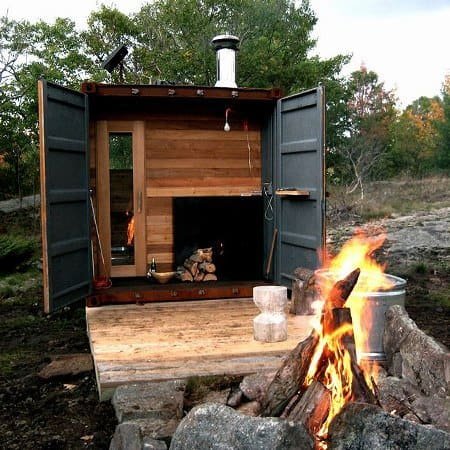Deciding whether to construct with new or used containers doesn’t have to be a difficult choice, which is why I have created the perfect guide to assist you.
Types of Shipping Containers
Before deciding on buying new or used containers, you must first determine the type of containers you want to purchase. Selecting the right container for your home requires thorough research. The containers most commonly used for homes and offices are standard containers or high cube containers.
However, there are other types of containers available, such as:
- Car Carrier,
- Dry Storage,
- Flat Rack,
- Insulated,
- Open Top,
- Open Side, and
- Tunnel Containers.
I have seen some houses built with insulated containers, but the majority are constructed with standard or high cube containers. In fact, the most crucial consideration when building is to remember that it is best to use high cube containers.
As an additional note, if you’re thinking of constructing a home with containers and a swimming pool, containers with open tops make for the perfect pool!
High Cube Containers
The difference between a high cube container and a standard container lies in their height and cost. High cube containers are one foot taller, providing more volume, space, and a higher ceiling for your home.
This feature appeals to many individuals who prefer high ceilings, stairs, chandeliers, or additional lighting, such as skylights or a solar roof.
The additional space you gain with a high cube container is usually advantageous for your home, but do keep in mind that it also means a bit more work to build and insulate the containers. They are available in lengths of either 20 or 40 feet.
We have written an article on container dimensions to detail the various sizes they come in.
Standard Containers
Standard containers also come in lengths of 20 or 40 feet, but their height is only 8 feet and 6 inches. They are the most commonly used containers by freight shipping companies, as most terminals, cargo ships, and semi-trailers can handle these container sizes.
The advantage of this is that you can easily find a used container. Due to their popularity, they are cheaper than other specialized containers.
Shipping a standard container to the construction site or home location is cheaper than transporting a high cube container. However, as a downside, standard containers have only around 1,700 cubic feet of space, while high cube containers have over 2,500 cubic feet.
Once you’ve decided which style to use, let’s discuss the advantages and disadvantages of building with new or used containers.
Advantages and Disadvantages of Building with New or Used Containers
1. Advantages of Building with New Containers
A brand-new container can cost over $2,500, depending on the place of purchase, size, and chosen style. The significant advantage of a new container is the peace of mind you’ll have when living in it and turning it into your home.
Knowing that it has never been exposed to harsh chemicals to protect it from seawater and has not been used to transport toxic products provides reassurance.
A brand-new container also gives you the option to choose how it’s made and select the container size. You can also customize the interior of your container, such as installing a custom wood floor to your liking.
This saves you time on modifying the container upon receipt. A often unspoken benefit of buying new containers is their availability. Since you’re buying them new, you can order exactly what you want.
If you’re buying used containers, you sometimes have to take what’s available. It can be challenging to find used high cube containers. Finally, new containers usually come with a warranty of at least 10 years.
If something goes wrong with your new containers, such as paint corrosion, it will be covered by the manufacturer’s warranty. We discuss this further in: What is the lifespan of a container house?
2. Disadvantages of Building with New Containers
New containers can cost up to three times more than a used shipping container. While this money is not recoverable, it is the cost of knowing that your containers have never been used.
Another disadvantage is that it can take up to three months to receive a new container shipped from China.
You can buy a used container and have it delivered within the week after purchase. For people living in port cities, a used container can be delivered within a few days.
Lastly, and perhaps the biggest drawback, is that they are not environmentally friendly. This means you are not recycling or reusing the container. What you are doing is using a container for building your home.
3. Advantages of Building with Used Containers
Used containers can be purchased starting from $1,000, depending on the location and size. Building with used containers reduces your costs, but there are downsides to used containers. The second advantage of used containers is that they are very easy to find and purchase.
There are millions of used containers traveling across the oceans at all times. If you were to go to eBay or Aliexpress, you would find a container ready to be shipped today, visit our store.
Due to the large number of used containers, finding one that suits your preferences and is close to you is easy and allows you to start building your home sooner than if you were to buy a new one.
Read our guide on how to buy containers for more information. One of the biggest advantages of used containers is that they are an eco-friendly option. By buying a used container, you are removing an element that would otherwise take up space and spread toxins in the environment.
Transporting it to your land and reconstructing it into your home or office allows you to help the atmosphere and the surrounding environment. Many governments offer tax deductions or credits when a dwelling is eco-friendly, giving you another incentive to build with a used container rather than a new one.
4. Disadvantages of Building with Used Containers
Unfortunately, used containers are not always the right answer. An older shipping container may be rusted, have a damaged door, or be in poor condition due to pesticides, chemicals, and certain paints used to withstand the oceans.
To avoid this, make sure to make the purchase of your container in person. When that’s not possible, i.e., if you’re buying online, I recommend requesting a video or enlarging the images so you can see what you’re buying and understand the amount of work involved.
Another disadvantage of used containers is that you don’t know what they have been used for; what has been transported in them? There are no international regulations that require shipping and freight companies to report exactly what goes into each container or to log precisely what happens throughout their journey.
The lack of history involved in purchasing a used container sometimes makes it a gamble, and you rely on your luck. However, if you thoroughly inspect the containers beforehand and clean them with sandblasting once received, they should be satisfactory for building your home.
By now, I hope you know whether you will buy new or used containers. The next step in your journey is placing your containers on their foundations.
Let me know your thoughts on building with new and used containers in the comments below.




